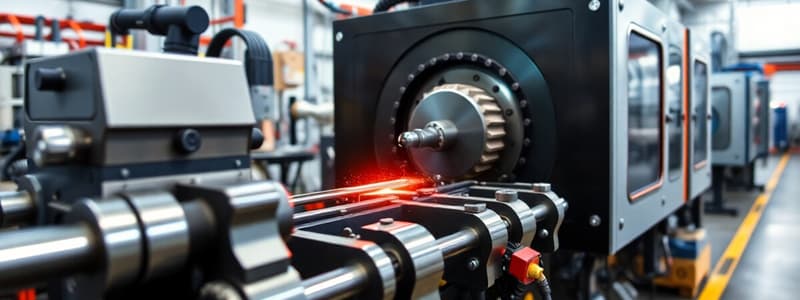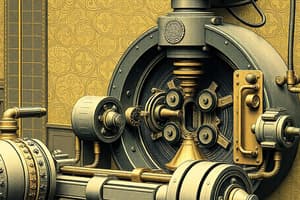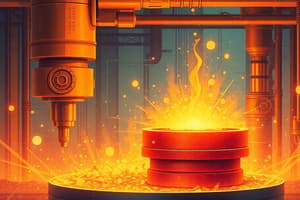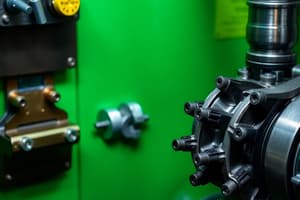Podcast
Questions and Answers
What is the primary function of an engine lathe?
What is the primary function of an engine lathe?
- To cut material using multi-tooth saw blades
- To rotate a workpiece against a cutting tool (correct)
- To generate electrical power for other machines
- To produce flat and angled surfaces
Which operation is NOT typically performed on an engine lathe?
Which operation is NOT typically performed on an engine lathe?
- Drilling
- Facing
- Sawing (correct)
- Reaming
What type of machine tool is primarily used for accurate holemaking operations?
What type of machine tool is primarily used for accurate holemaking operations?
- Band Saw
- Engine Lathe
- Power Hacksaw
- Milling Machine (correct)
Which of the following is a type of sawing machine?
Which of the following is a type of sawing machine?
In what industries is machining particularly significant?
In what industries is machining particularly significant?
Which of the following is NOT a common tool operation performed on an engine lathe?
Which of the following is NOT a common tool operation performed on an engine lathe?
What is the most commonly used sawing machine in workshops?
What is the most commonly used sawing machine in workshops?
Which machine tool is best known for producing cylindrical parts?
Which machine tool is best known for producing cylindrical parts?
What is the primary function of a drill press?
What is the primary function of a drill press?
How are standard machine tools categorized?
How are standard machine tools categorized?
What advancement significantly changed the operation of machine tools over time?
What advancement significantly changed the operation of machine tools over time?
Which of the following is NOT considered a standard machine tool?
Which of the following is NOT considered a standard machine tool?
What is the definition of machining according to Merriam-Webster’s Dictionary?
What is the definition of machining according to Merriam-Webster’s Dictionary?
Which machine tool is known for providing greater power and control compared to hand-held tools?
Which machine tool is known for providing greater power and control compared to hand-held tools?
What factor is critical in determining the specific application of each machine tool?
What factor is critical in determining the specific application of each machine tool?
Which statement best describes the history of machine tools?
Which statement best describes the history of machine tools?
What is a standard objective of studying machine tools?
What is a standard objective of studying machine tools?
In what historical period did the development of machine tools begin?
In what historical period did the development of machine tools begin?
Which aspect is NOT covered in the objectives of machine tools study?
Which aspect is NOT covered in the objectives of machine tools study?
What is a primary focus of the introduction to machine tools?
What is a primary focus of the introduction to machine tools?
Which group authored the book 'Technology of Machine Tools'?
Which group authored the book 'Technology of Machine Tools'?
Flashcards
Machining Definition
Machining Definition
Using machine tools to cut materials to desired sizes and shapes; reducing/finishing objects with machine tools.
Machine Tools
Machine Tools
Power-driven metal cutting or forming machines used to shape metal.
Drill Press
Drill Press
A machine used to create round holes in materials.
Engine Lathe
Engine Lathe
Signup and view all the flashcards
Milling Machine
Milling Machine
Signup and view all the flashcards
Sawing Machine
Sawing Machine
Signup and view all the flashcards
Standard Machine Tools
Standard Machine Tools
Signup and view all the flashcards
History of Machining
History of Machining
Signup and view all the flashcards
Engine Lathe Function
Engine Lathe Function
Signup and view all the flashcards
Engine Lathe Operations
Engine Lathe Operations
Signup and view all the flashcards
Milling Machine Function
Milling Machine Function
Signup and view all the flashcards
Milling Machine Types
Milling Machine Types
Signup and view all the flashcards
Sawing Machine Types
Sawing Machine Types
Signup and view all the flashcards
Power Hacksaw
Power Hacksaw
Signup and view all the flashcards
Machine Tool Benefits
Machine Tool Benefits
Signup and view all the flashcards
Machining Applications
Machining Applications
Signup and view all the flashcards
Stone Age Machining
Stone Age Machining
Signup and view all the flashcards
Space-Age Machines
Space-Age Machines
Signup and view all the flashcards
Machine Tool History
Machine Tool History
Signup and view all the flashcards
Machine Tool Applications
Machine Tool Applications
Signup and view all the flashcards
Study Notes
Machining Technology
- Machining is the process of shaping materials using machine tools. It involves reducing or finishing materials using tools. Techniques include turning, shaping, planning, or milling.
- Machining relies on machine tools for precise cutting of materials into desired shapes and sizes.
- Machining has evolved from very basic forms to advanced technology, employing precision and efficiency. Early methods utilized manpower and animals; later, water, steam, and ultimately, electricity powered tools.
- Advancements in machining significantly impact several industries, including aerospace, automotive, and motorsports. Industries are heavily reliant on machining for producing components like gears, wheels, bolts, engines, and drive trains.
- Machining is vital to the medical field, creating numerous medical devices, such as artificial hearts.
Machine Tools
- Machine tools are the fundamental equipment used in machining.
- Common machine tools include drill presses, engine lathes, milling machines, and sawing machines.
- These tools use multi-tooth blades or other cutting tools to form or shape various metals or other materials..
- Drill presses are primarily for creating holes, utilizing rotating cutting tools to cut into workpieces.
- Engine lathes are versatile tools for making parts with cylindrical shapes, through processes like turning. Turning, tapering, facing, drilling, boring, reaming, and thread cutting are common operations on engine lathes.
- Milling machines are crucial for creating flat and angled surfaces. They employ rotating cutters to shape materials in a variety of ways including removing material. CNC milling machines have a more extended range of capabilities, including curves and contours.
Types of Sawing Machines
- Sawing machines, frequently used for cutting materials, include:
- Power hacksaws
- Band saws
- Abrasive cut-off saws
- Cold saws
- Power hacksaws are commonly employed in many workshops.
Benefits of Machining Technology
- Machining technology plays a significant role in various sectors, contributing to manufacturing and shaping modern products.
- It is used extensively in aerospace, automotive, and motorsport industries, enabling precise creation of components.
- Machining is crucial in producing high-quality products including those in the medical field, leading to the production of critical medical devices. Artificial hearts are a notable example.
- Durable goods, such as hardware, glass products, metal cans, and hand tools, and consumable goods, like clothing, paper, and plastic packaging, demonstrate the transformative impact of machining technologies on society.
Studying That Suits You
Use AI to generate personalized quizzes and flashcards to suit your learning preferences.




